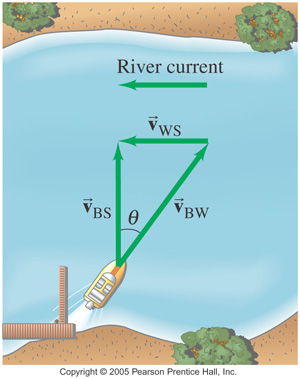 Self Check: Trigonometric Ratios
Self Check: Trigonometric Ratios
Now, you try. Complete the self-check activity by looking at the prompt below, working through it, and then clicking on the question to review the solution.
Jean camps beside a wide river and wonders how wide it is. She spots a large rock on the bank directly across from her. She then walks upstream until she judges that the angle between her and the rock, which she can still see clearly, is now at an angle of 30° downstream. Jean measures her stride to be about one yard long. The distance back to her camp is 120 strides. About how far across is the river in meters?
Consider the diagram shown. L is the distance she walks upstream, which is about 120 yards. Find the distance across the river from the diagram.
Then, find how many meters are in 210 yards:
|

A boat’s speed in still water is 1.85 m/s. If the boat is to travel directly across the river whose current is 1.20 m/s, at what upstream angle must the boat head?
In this case, you know the length of one of the sides (speed of the water with respect to the shore) and the hypotenuse (speed of the boat with respect to the water) of the triangle and you need to find the angle theta from the diagram. Use the sine ratio to find the angle measure (if you are using a calculator, make sure that “angle” is set to “degrees” in the setup).
|

To move directly across the river, the boat must head upstream at an angle Θ. Velocity vectors are shown as green arrows

